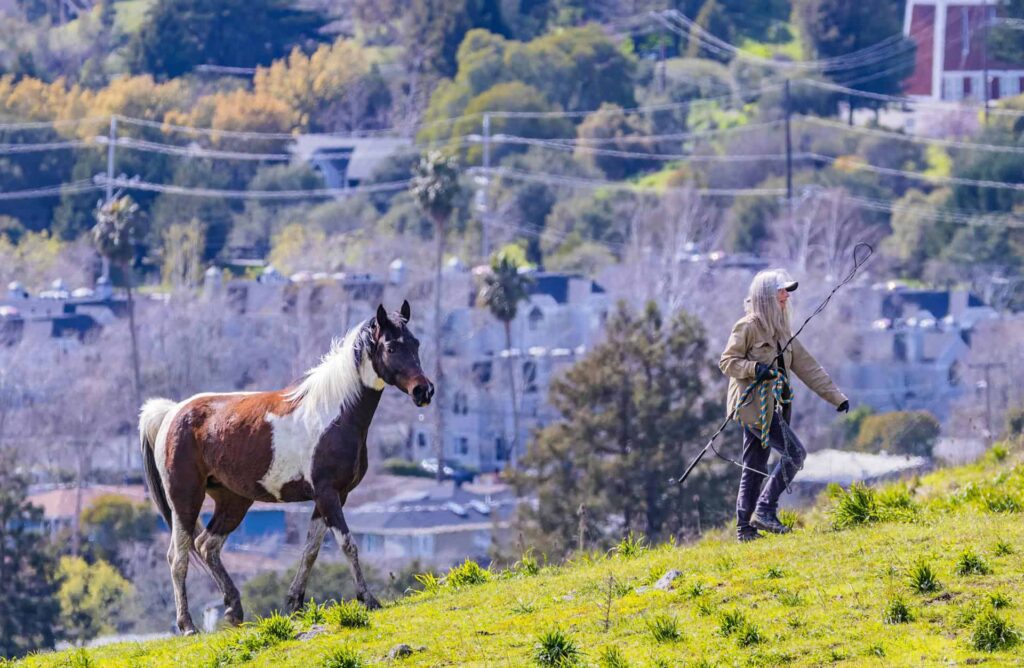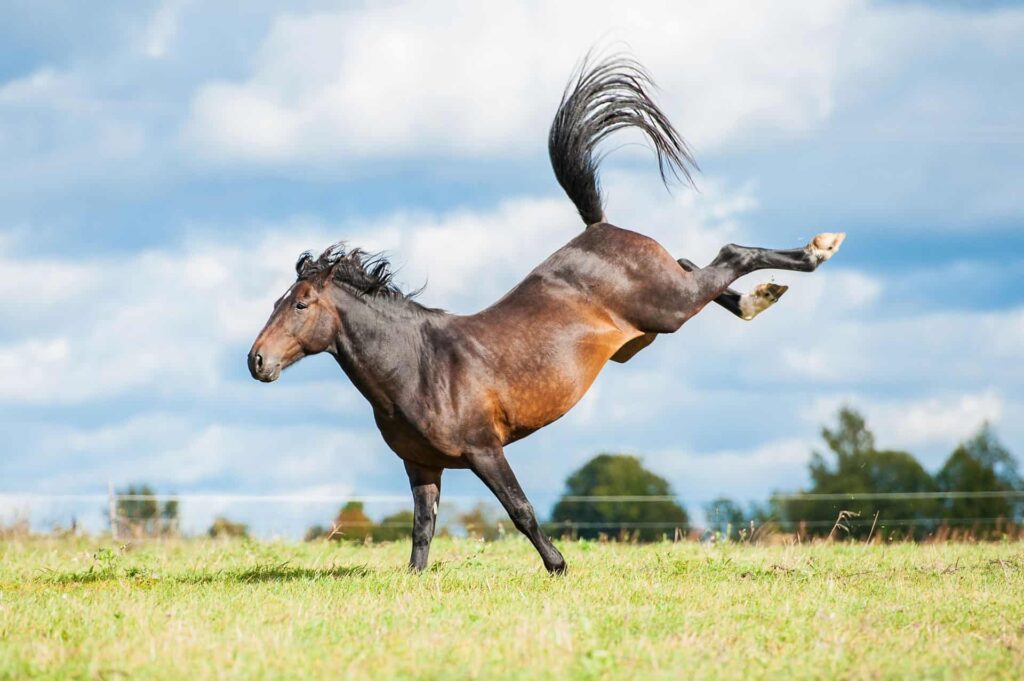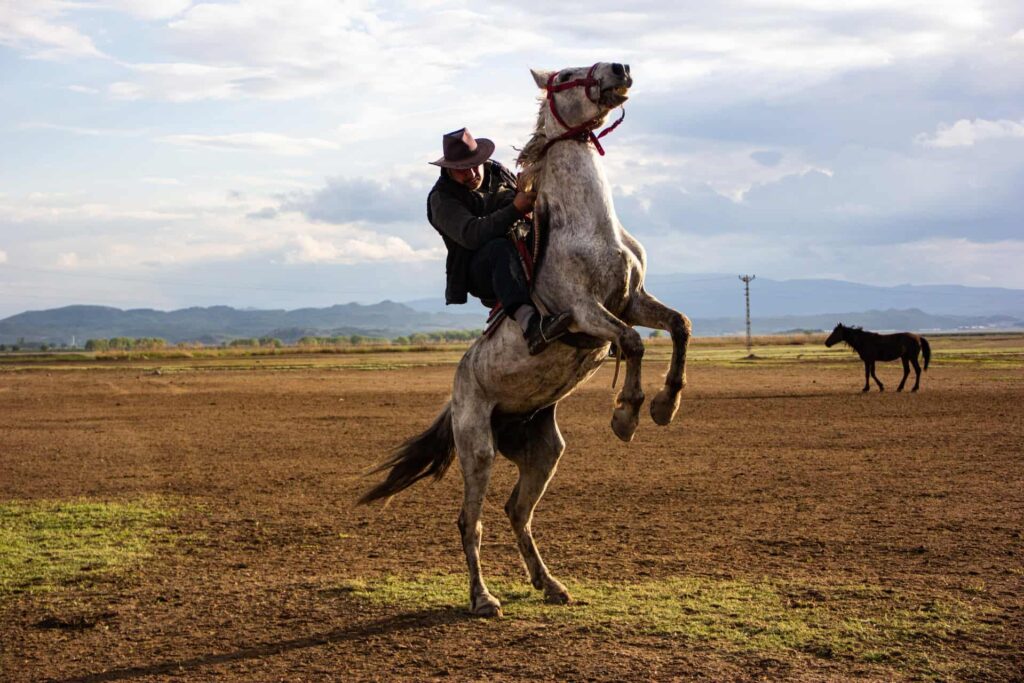Long reining, also known as double lunging, is an effective training technique used in the equestrian world to develop a horse’s balance, strength, and responsiveness to aids while giving the rider an opportunity to correct and refine movements from the ground. This method involves the horse being guided by two long reins that simulate the aids and control of riding, allowing for nuanced communication and adjustment of the horse’s posture and stride without the weight of the rider.
It’s an invaluable skill that enhances the horse’s understanding of commands and aids in muscle development, particularly useful for young horses or those in rehabilitation. Long reining can be a diagnostic tool for riders to assess and address issues seen under the saddle, observing the horse’s movement and symmetry from a clear vantage point. It sets a solid foundation for advanced-ridden work and can significantly increase the horse’s performance and willingness over time.
Key Takeaways
- Long reining benefits a horse’s training by improving balance and responsiveness.
- It allows riders to observe and correct equine movement from the ground.
- This technique serves as a foundation for further ridden exercises and refinement.
Understanding Long Reining
Long reining, also known as long-lining, is a classical equestrian practice that has evolved over the centuries. It is a training technique that offers numerous benefits, including enhancing a horse’s balance and coordination.
History and Evolution
Initially developed for driving horses, long reining has its roots in the classical dressage training of European horsemanship. It has evolved to be a standard practice in various disciplines, allowing for a horse to be trained from the ground. Over time, long reining has become a beneficial exercise in developing a horse’s strength and carriage, before transitioning to under-saddle work.
Definition and Purpose
Long reining involves the use of two long lines that enable the handler to direct and train the horse from the ground. The purpose of long reining is multifaceted: it is used to school horses, help them exercise, and prepare them for riding or reining. This method allows the horse to become accustomed to commands and aids without the weight of a rider, improving their responsiveness and building trust between horse and handler.
Fundamentals of Long Reining
Long reining, also known as double lungeing, is an effective method for training horses, promoting both physical conditioning and responsive communication. This training technique emulates the cues and aids used when riding but is performed from the ground, offering a unique perspective for evaluation and correction.
Equipment and Tack
For successful long reining, the correct equipment is key. The essentials include a well-fitting roller, which gives the handler various options for positioning the reins, and a snaffle bridle to ensure clear, direct communication with the horse. The long reins should be made of a material that allows easy glide through the roller’s rings without causing burns to the handler’s hands, hence gloves are recommended for protection.
- Bridle: Snaffle bridle
- Reins: Long reins (approximately 30 to 35 feet in length)
- Roller: A padded roller to prevent discomfort or injury
- Protection: Durable gloves to safeguard the handler’s hands
Basic Commands and Signals
Through voice commands and the manipulation of reins, the handler guides the horse, establishing directional, gait, and speed cues. Correctly used body language, juxtaposed with voice commands, enhances the horse’s understanding. Legs and body positioning by the handler mirror the equestrian’s aids when mounted, facilitating a smoother transition for the horse from groundwork to under-saddle work.
- Voice Commands: Indicate actions like “walk,” “trot,” “halt,” or “back.”
- Reins: Apply pressure on either side of the body to direct turns and encourage bending.
- Body Signals: The handler’s position in relation to the horse’s body influences movement and speed.

Preparing the Horse for Long Reining
Before introducing a horse to the challenge of long reining, start by making sure that they are comfortably accustomed to both the equipment and the commands. Both young and older horses may require a slow and steady approach to build confidence and understanding.
Introducing the Horse to Long Reins
When starting with long reining, one must introduce the horse to the long reins gradually. The process begins with them simply seeing and smelling the equipment to become familiar with its presence. Initially, lay the reins over the horse’s back during grooming sessions to establish a sense of normalcy around the gear. Afterward, one can progress to draping the reins alongside the horse, ensuring that they are not startled by the feel of the lines. For young horses especially, this can prevent any future issues of alarm when the reins touch their sides during training.
- Lay the reins over the back during grooming.
- Progress to draping the reins alongside.
Safety Measures
Safety is paramount when working with long reining. The trainer should don protective gear including a helmet, boots, and gloves before each session. When preparing the horse, make sure they’re fitted with a suitable bridle and that all associated equipment is secure and in good repair. This preparation minimizes the risk of equipment failure and potential injury. In the context of safety, it’s also vital to introduce commands steadily, reinforcing them consistently to establish clear communication between the trainer and the horse.
- Trainer’s safety equipment: Helmet, boots, gloves
- Check the horse’s gear for security and integrity.
Starting Long Reining Practices
In long reining, establishing a foundation of trust and communication through groundwork is critical, and the initial reining sessions are central to developing future skills. Safety and setting the stage for successful training hinge on a methodical and patient approach.
Groundwork and Leading
Groundwork lays the base for any quality training session. Begin by checking that the horse is responsive to basic commands such as “walk” and “halt”. It’s important for the horse to maintain balance and light contact with the trainer, establishing a sense of confidence on the ground. The trainer should use lunge lines strategically positioned to guide the horse, facilitating a smooth transition into long reining.
- Preparation Checklist:
- Comfortable bridle and roller/saddle pad
- Two distinct-colored lunge lines for clear direction
First Reining Session
Introducing the reins during the initial session is done gradually, with a focus on applying consistent pressure as cues. The horse is guided to walk in a circle, allowing it to get accustomed to the feel of the reins along its flanks. In the arena, one should work on maneuvers such as turning and halting, instilling the basics of direction and pace. Make sure that the horse remains balanced and the contact with the mouth is kept gentle and steady.
- Key Actions:
- Initiate with simple, straight walks before progressing to circles
- Maintain soft and steady contact to build trust
Long Reining Techniques
Long reining is an equestrian skill where mastery over finesse, such as the subtle use of pressure and feel, guides the horse through complex movements. Proper contact and balance are key components as they help maintain clear communication and steady direction.
Movement and Direction Control
Effective long reining begins with an understanding of how to control movement and direction. Steering involves gentle yet assertive pressure on the reins to guide the horse. For example, to initiate a turn, the trainer applies pressure on one rein, signaling the horse to move away from it. It is crucial for the trainer to maintain a consistent rhythm and forward momentum while ensuring the horse is responsive to directional cues. Simple movements such as straight lines and circles help in developing feel and contact.
- Always apply pressure evenly to avoid confusing the horse.
- Stop the horse with equal pressure on both reins combined with a verbal command.
- Practice moving in serpentines to enhance directional control and flexibility.
Advanced Maneuvers
Once basic directionality is secure, integrating more advanced maneuvers such as lateral work and piaffe can begin. Lateral work enhances your horse’s balance and coordination while training in piaffe fosters strength and discipline. These techniques require a high level of communication between the trainer and the horse, using refined signals to shift weight and manage movement.
- Turning on the haunches involves shifting the horse’s weight to its hindquarters while executing a tight turn.
- Developing smooth transitions maintains a consistent rhythm and momentum.
- Incorporate halts into serpentines and straight lines to improve stopping on command.
Strategically increasing the complexity of the long reining exercises strengthens the trust and contact between horse and trainer.
Developing Skills with Long Reining
Long reining is a compelling technique for enhancing the skills of both the horse and rider. It necessitates a steadfast rapport and develops the physicality required for advanced equestrian maneuvers.
Building Trust and Responsiveness
When undertaking long reining, the horse learns to trust the cues provided by the rider, even when they are out of sight. This trust builds a sturdy bond between horse and rider, which is necessary for achieving a high level of responsiveness. Horses begin to follow commands with more attention and awareness, primarily when introduced to this training at a young stage, fostering confidence without the rider’s immediate presence.
- Trust: Critical for horses to accept remote guidance
- Responsiveness: Improved through consistent and clear commands
Enhancing Physical Fitness and Coordination
Long reining serves as an excellent foundation for a horse’s fitness and coordination. It allows the horse to develop muscle and balance without the weight of a rider, leading to better body condition and strengthened hindquarters and shoulders. Through long reining, a horse enhances its way of going, moving with a more athletic posture and refined coordination, as evidenced in complex movements like the piaffe.
- Fitness: A horse’s muscular strength and cardiovascular health
- Coordination: The smoothness and efficiency of a horse’s movements
By focusing on these areas, long reining is a transformative tool that finely tunes the skills necessary for both the horse and rider in various equestrian disciplines.

Application of Long Reining
Long reining is a versatile training method used to foster trust, establish foundational aids, and prepare horses for various disciplines and rehabilitation. It allows communication from a distance, simulating ridden work conditions without the weight of a rider.
Training for Specific Disciplines
Long reining serves as a powerful tool in training for specific disciplines such as dressage, driving, and reining. In dressage, it helps horses learn to respond to rein and voice aids, crucial for movements that require precision and finesse. For horses being trained for driving, long reining instills confidence with ropes and equipment around their bodies and simulates the feel of a carriage behind them.
Rehabilitation and Conditioning
In the context of rehabilitation and conditioning, long reining offers significant benefits. It allows equine athletes to maintain fitness while recovering from injury by facilitating exercise without the stress of a rider’s weight. Utilized strategically, long reining can aid in a gradual and controlled return to optimal performance levels, emphasizing a variety of movements that provide a comprehensive rehabilitation process.
Challenges and Solutions in Long Reining
Long reining can present various challenges to both the horse and the handler. With the right approach and understanding, these issues can be effectively addressed. Here are some common difficulties encountered during long reining and their practical solutions.
Common Issues and Their Remedies
- Challenge: Tension in the Outside Rein
- Solution: To remediate tension, make sure the outside rein is used to support the horse rather than to pull against it. One must maintain a steady, gentle contact that encourages the horse to turn its head slightly to the outside while simultaneously asking for a slight bend through the body.
- Challenge: Lack of Straightness
- Solution: Promote straightness by walking alongside the horse’s shoulder, using even pressure on both reins. If the horse drifts, use subtle half-halts to correct its path.
- Challenge: Disengaged Quarters
- Solution: Encourage the engagement of the horse’s hindquarters by alternating the focus between the inside and outside reins. This directs the energy from the hindquarters and maintains forward momentum.
- Challenge: Incorrect Bend
- Solution: Proper bend is achieved by balancing the use of both reins. The inside rein gently asks for the bend while the outside rein limits the bend and prevents over-flexing.
When applied correctly, these solutions help improve the horse’s response to the long reining process, leading to a more fruitful and pleasant experience for both the horse and handler.
Frequently Asked Questions
Long reining is a versatile horse training technique that engages a horse’s body and mind. It is used for developing a horse’s way of going, introducing them to commands, and preparing them for ridden work.
How do you start long-reining a young horse?
To start long reining a young horse, one should begin with basic groundwork to help the horse become comfortable with the handler and the equipment. Paced progression and patience are key, allowing the young horse to understand and respond to the commands given through the reins.
What equipment is necessary for long reining?
The necessary equipment for long reining includes a bridle, a long pair of reins or lines, and sometimes a long reining roller or surcingle. A well-fitted bridle helps to convey subtle cues, and the reins must be of appropriate length to maintain contact while allowing the horse freedom of movement.
Are there any specific benefits of long reining for horse training?
Long reining offers specific benefits for horse training such as helping improve straightness, encouraging the horse to accept contact, and increasing the variety in a training regime. It also provides a controlled way to introduce horses to new environments without the weight of the rider.
What are the differences between long reining and lunging?
The primary difference between long reining and lunging lies in the horse’s movement patterns. Lunging typically involves the horse moving in circles, while long reining allows for work on straight lines, circles, and other movements, providing a more comprehensive range of exercises.
Can long reining be beneficial for senior horses?
Long reining can be beneficial for senior horses by offering a low-impact exercise option that maintains fitness and mental stimulation without the stress of carrying a rider. It is a useful tool for keeping older horses supple and engaged in their training.
What are the potential drawbacks of long reining?
The potential drawbacks of long reining include the need for skilled handling to avoid confusing or over-facing the horse. It requires a consistent and patient approach to prevent the creation of bad habits. Without proper technique, there is a risk of causing physical strain on the horse.
Last Updated on November 27, 2023 by Nate Dewsbury



